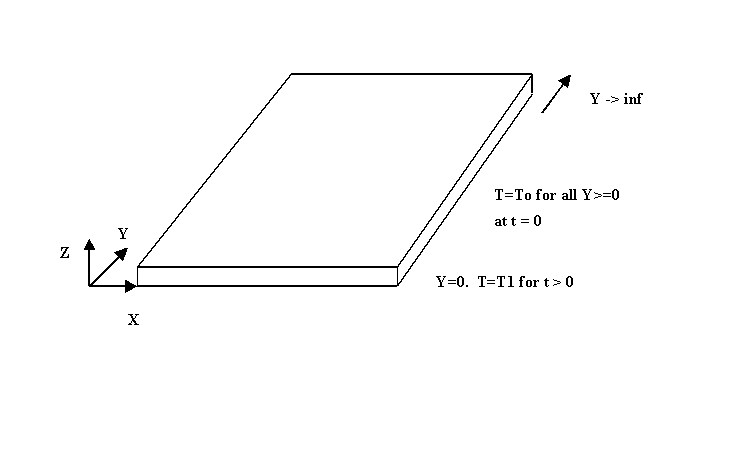
Example 11.1-1 Heating of a Semi-infinite Slab
Whitney Smith and Andy Edgar
Ceng 402 Project, April 28, 2000.
A solid body occupying the space from y=0 to y=inf is initially at temperature To. At time t=0, the surface at y=0 is suddenly changed to temperature T1 and maintained at the temperature for t > 0. Find the time dependent temperature profiles T(y,t).

> restart;
eq. 11.1-3 - Equation 11.1-2 modified for dimensionless temperature profile Theta = (T-To)/(T1-To) and with respect to y. Alpha = k / (rho*Cp), the thermal diffusivity of the solid. k is the thermal conductivity, rho the density, and Cp the heat capacity at constant pressure.
> eq:=D(Theta)(t)=alpha*D(D(Theta))(y);
![]()
Define eta as in chapter 4 (ex. 4.1-1), dimensionles variable in terms of y.
> eta:=y/sqrt(4*alpha*t);
![]()
Use the chain rule on left hand side of eq
> chain1:=D(Theta)(eta)*diff(eta,t);
![[Maple Math]](images/project3.gif)
Chapter 11 equivalent of right hand side of equation 4.1-5. (Phi = Theta)
> bookeq1:=D(Theta)(eta)*(-.5)*eta/t;
![[Maple Math]](images/project4.gif)
Prove book equation is the chain rule expansion of D(Theta)(t), ie. that equation 4.1-5 is true for this example.
> simplify(chain1-bookeq1);
![]()
Use chain rule to expand right hand side of eq.
> chain2:=D(D(Theta))(eta)*diff(eta,y)*diff(eta,y);
![[Maple Math]](images/project6.gif)
Chapter 11 equivalent of right hand side of equation 4.1-6.
> bookeq2:=D(D(Theta))(eta)*eta^2/y^2;
![[Maple Math]](images/project7.gif)
Prove book equation is the chain rule expansion of D(Theta)(t), ie. that equation 4.1-6 is true for this example.
> simplify(chain2-bookeq2);
![]()
Rearranging eq in terms of the chain rule expansions defined above.
> bigeq:=alpha*chain2-chain1=0;
![[Maple Math]](images/project9.gif)
> simplify(bigeq);
![[Maple Math]](images/project10.gif)
Further simplification shows that 1/(4*t) is common to both terms and can be eliminated from the equation.
> eq3:=simplify(4*t*bigeq);
![[Maple Math]](images/project11.gif)
Return eta to its variable form to leave solution in dimensionless form.
> eta:='eta';
![]()
To get back to dimensionless form, define y in terms of eta.
> y:=2*eta*sqrt(alpha*t);
![]()
Dimensionless form of eq
> eq4:=simplify(eq3);
![]()
Solve eq using dsolve and boundary conditions given in equations 11.1-5 and 11.1-6.
> s:=dsolve({eq4,Theta(0)=1,Theta(inf)=0},Theta(eta));
![]()
> assign(s); Theta:=unapply(Theta(eta),eta);
![]()
To simplify, we see that as n goes to infinity, erf(n) goes to 1.
> evalf(erf(1000000));
![]()
In light of this, define erf(inf) as 1.
> erf(inf):=1;
![]()
Simplify solution to get equation 11.1-7.
> Theta(eta):=simplify(Theta(eta));
![]()
Since eta depends on both y and t, this solution is the dimensionless temperature profile in terms of both variables.
Now for a numerical example.
We begin with the equation developed above for Theta.
> restart;
> eq:=Theta=1-erf(eta);
![]()
State the definitions of the dimensionless parameters Theta and eta.
> Theta:=(T-To)/(T1-To); eta:=y/sqrt(4*alpha*t);
![]()
![]()
Show that the definition of the Theta equals the solution we developed for Theta.
> eq;
![]()
Solve the equation originally in terms of Theta for T.
> T:=solve(eq,T);
![]()
Define given constants for the case where the slab is made of steel (constants from BS&L Problem 11D).
> k:=25*4.1365e-3*cal/s/cm/C; rho:=7.7*g/cm^3; Cp:=.12*cal/g/C;
![]()
![[Maple Math]](images/project26.gif)
![]()
> To:=(1000-32)*5/9*C; T1:=(200-32)*5/9*C;
![]()
![]()
> alpha:=k/rho/Cp;
![[Maple Math]](images/project30.gif)
Use the equation solved for T above to find the temperature at a given height y in the slab at a time t after the surface temperature is changed.
> y:=1*cm; t:=10*s; simplify(T,assume=positive);
![]()
![]()
![]()
> y:=100*cm; t:=1000*s; simplify(T,assume=positive);
![]()
![]()
![]()
> y:=1*cm; t:=1000*s; simplify(T, assume=positive);
![]()
![]()
![]()
>